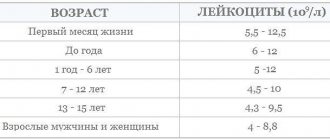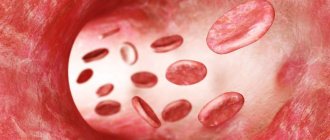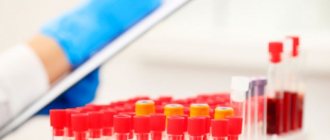Complexes with this research
Male check-up No. 1 39 studies for annual preventive examination 18,570 ₽ Composition
Miscarriage Identification of the main causes of miscarriage 40,070 ₽ Composition
Risk of severe COVID-19 Diagnosis of prediabetes and bleeding disorders RUB 1,090 Composition
IN OTHER COMPLEXES
- Joining IVF RUB 23,020
- Examination during pregnancy. 3rd trimester 9,620 RUR
- Women's check-up No. 1 RUB 19,290
- Female infertility RUB 16,210
- For those at risk of COVID-19 RUB 4,510
Why do you need to know the INR?
INR analysis is a common research method during the diagnosis of cardiovascular diseases. In addition, bleeding and severe thrombus formation are direct indications for studying all parameters affecting coagulation.
Knowing the INR is very important for the cardiologist who prescribed anticoagulants to the patient, since this allows him to control the correctness of the dose calculation, in order not to harm the patient. This also includes taking warfarin, the dosage of which is determined for each patient individually.
In case of cirrhosis of the liver or other disease of the filtering organ, it is also important to know the INR level, because it is the liver that produces many factors that clot the blood.
A separate group of patients are pregnant women. First of all, this is due to the fact that the entire body system begins to work differently during pregnancy. The level of hormones and enzymes changes, and the volume of blood circulating through a woman’s veins increases. Hence the need to control the functioning of the hematopoietic system. Due to the high level of blood clot formation, the likelihood of complications is high. And if the blood is too thin and there is a lack of platelets, there is a high probability of dangerous bleeding during childbirth.
At the very beginning of labor, each woman in labor is given a catheter in a vein, into which, if necessary, an IV will be placed with a composition that increases the level of blood clotting to prevent large blood losses.
Detailed description of the study
Normal blood clotting is possible by maintaining a balance between the processes of blood clot formation and mechanisms that prevent excessive blood clotting.
Prothrombin is a protein that is produced in the liver and plays an important role in blood clotting. Under its action, blood clots form in case of damage to the vascular wall, and bleeding stops.
Prothrombin time (PTT) is the time in seconds it takes for a blood clot, or thrombus, to form.
Prothrombin index (PTI) is a value equal to the ratio of the PTI of the control sample to the PTI of the test sample, expressed as a percentage. The indicator is also used in conjunction with other tests included in the coagulogram to assess the risk of thrombosis or bleeding.
INR (international normalized ratio) is a calculated value characterizing the ratio of prothrombin time and prothrombin index. This indicator is used to monitor treatment with indirect anticoagulants. These drugs reduce the body's ability to form blood clots by blocking the formation of clotting factors. Patients taking anticoagulants should regularly monitor this indicator to prevent complications of anticoagulant therapy. The frequency of INR testing is determined by the attending physician.
Cardiovascular diseases, liver pathology, diabetes mellitus and some other conditions contribute to an imbalance between the blood coagulation and anticoagulation systems. During pregnancy, there is also some change in PTT, PTI and INR. It is caused by changes in hormonal regulation and related factors and usually refers to physiological conditions.
An increase in PTT may be associated with bleeding, and its reduction increases the risk of thrombosis. To prevent complications associated with thrombosis, drugs are prescribed that reduce the likelihood of vascular clot formation - anticoagulants. At the same time, these medications, if the dose is incorrectly selected, increase the risk of bleeding, which requires specialist supervision.
The results of the analysis reflect the value of all three indicators. Assessment of PTT, PTI and INR will help the doctor assess the state of the blood coagulation system and select treatment.
INR norm
Units are used to express INR. The higher the INR, the less blood contains prothrombin and other factors that affect coagulation. The INR of a healthy person ranges from 0.85 units. up to 1.37 units. At the same time, the patient’s age affects the values of the norms:
- Newborns and children of the first year of life – from 0.9 units. up to 1.25 units
- Children from one to six years old can normally have 0.95-1.1 units.
- In patients aged 12-16 years, the normal INR ranges from one to 1.35 units.
- After 16 years, the value should be within 0.85 units. – 1.3 units.
For those who have already been prescribed anticoagulant therapy, the INR should be between 2.0 units. up to 3.0 units, because drugs that fight the formation of blood clots do not allow the blood to thicken, which also affects the prothrombin index.
If a patient is not taking blood thinning medications, but his INR is higher than normal, this may indicate:
- liver diseases;
- coagulopathies;
- prothrombin deficiency;
- lack of fibrogen;
- vitamin K deficiency;
- taking certain medications that affect blood composition;
A low INR always indicates that a person is at risk. Value below 0.5 units. reports the onset of venous thrombosis.
Coagulogram - what is it?
Many patients needlessly begin to worry when they hear from their attending physician such unusual at first glance words as coagulogram or otherwise hemostasiogram . So what kind of coagulogram analysis is this and why is it taken?
First of all, it is worth noting that this is a fairly common method in modern medicine for studying the functioning of the hemostatic system of the human body, which is responsible for such important vital functions as stopping bleeding when blood clots or blood vessels , as well as maintaining the normal fluid state of the blood.
Hence the answer to the question of what a hemostasiogram - a study that determines how well the body’s hemostasis system functions. A blood coagulogram test helps to study such an important blood function as the ability to clot, i.e. formation of a blood clot.
Having received the results of coagulation , the attending physician can predict in advance the outcome of the operation or childbirth. Information about blood clotting is vital in emergency situations, for example, when a person is injured, when seconds count and you need to stop the bleeding .
Therefore, you hardly need to worry too much about how much this research costs. After all, the price of a hemostasiogram cannot be compared with the confidence that the patient will be alive and healthy.
Indications for prescribing such an analysis as a hemostasiogram are the presence of the following diseases in the patient:
- intestinal thrombosis;
- stroke;
- thromboembolism
- vascular thrombosis and varicose veins of the lower extremities;
- chronic cirrhosis
- gestosis;
- inflammatory processes in the acute stage;
- hemorrhagic pathologies, for example thrombocytopenia , hemophilia or von Willebrand disease .
In addition, such an analysis is necessarily prescribed to determine the rate of blood clotting in preparation for planned operations, for example, cesarean section, as well as during pregnancy to assess the state of hemostasis and before spontaneous childbirth . Every woman in labor must have a blood test such as a coagulogram in her exchange card.
Human hemostasis system
Having determined what a hemostasis test is, it is worth understanding in more detail such a concept as blood clotting . Perhaps we should start with a definition. So, the hemostasis system of the human body is the most important biological system, the main functions of which can be considered to be the preservation of basic blood parameters, as well as stopping bleeding.
It is not for nothing that the human body is called the whole universe and is compared to a complex mechanism. And the hemostasis system can serve as a striking example of how ingeniously people are designed. Blood is a unique biological fluid that can literally work miracles in our body.
It not only circulates through the vessels, but also, unnoticed by a person, restores veins and arteries throughout his life due to its ability to form blood clots or dense clots, i.e. roll.
There are three main components of the human hemostasis system:
- endothelial cells (the inner layer consisting of flat cells lining lymphatic and blood vessels, as well as the cavities of the heart), which, when vascular walls rupture or other damage, are capable of releasing biologically active components such as prostacyclin , thrombomodulin and nitric oxide . They, in turn, trigger the process of blood clot formation.
- Platelets or blood platelets that have the ability to “stick together” with each other in order to subsequently form a primary hemostatic plug .
- Plasma factors (15 plasma factors in total, most are enzymes ) that, due to chemical reactions, form a fibrin clot , which should finally stop the bleeding.
Summarizing all of the above, we can clearly answer the question of what a blood test for hemostasis shows during pregnancy, in preparation for a planned operation, or during diagnostics. This test gives an idea of how well or poorly a patient's blood is clotting. In other words, how quickly doctors can stop bleeding when it occurs.
Indications for prescribing INR
A blood test for INR is prescribed for certain indications. The normal range of this test varies depending on the underlying disease of the patient.
Indications:
- Preoperative examination of patients. The norm is closer to 1 (from 0.7 to 1.3, usually 0.85-1.25).
- Taking blood thinners (such as Warfarin). The norm is 2.0-3.0.
- Therapy for pulmonary embolism. The norm is 2.0-3.0.
- Condition after aortic valve replacement with a mechanical implant. The norm is 2.0-3.0.
- Condition after mitral valve replacement with a mechanical implant. The norm is 2.5-3.5.
- Preventive treatment of pulmonary embolism for heart defects. The norm is 2.0-3.0.
- Preventive treatment of deep vein thrombosis after surgery. The norm is 2.0-3.0.
INR analysis for patients taking blood thinners is carried out at certain intervals, which are determined individually by the doctor. At the beginning of the disease, when the patient is in the hospital, such tests are performed daily. Next, the patient is recommended to monitor the INR once a week and, if the test results are stable, then the frequency of tests can be reduced to once every 2-3 weeks.
The following changes in the patient’s life or symptoms of hypocoagulation may be the reason for prescribing an extraordinary test:
- long-term cold or other illness;
- changing the concomitant therapy regimen;
- lifestyle or diet changes;
- sudden climate change;
- unmotivated nosebleeds;
- bleeding gums;
- causeless appearance of hematomas;
- blood in urine:
- prolonged and heavy menstruation in women;
- streaks of blood in sputum or vomit;
- blood in stool (or tarry stool);
- prolonged bleeding from cuts;
- unexplained lumps, pain and swelling in the joints while taking a blood thinner.
General information
Every qualified doctor knows that it is best to begin the treatment of any patient by collecting an anamnesis, which is nothing more than a collection of information about the state of a person’s health.
As a rule, any medical examination begins with asking the patient himself about previous diseases or surgical interventions, allergic reactions or hereditary predisposition to certain ailments, and so on.
Then the doctor prescribes a series of laboratory tests or simply tests that will help supplement the anamnesis with information about the development of the disease, as well as information necessary for choosing a treatment method or further diagnosis.
Coagulological studies (abbreviated as coagulogram ) occupy an important place among laboratory blood tests that are necessarily carried out in preparation for surgery, for example, during a planned cesarean section or during pregnancy .
Interpretation of the obtained data and norms
The general rule that is used when assessing the INR during therapy with indirect anticoagulants is as follows: the higher the INR, the thinner the blood.
The resulting INR indicator can be interpreted as follows:
- INR corresponds to normal values - anticoagulant treatment is carried out correctly. Their dose is adequate. It is recommended to continue taking them in the same regimen;
- The INR is higher than the established norms for a specific pathology. This indicates an overdose of indirect anticoagulants, which can lead to complications in the form of bleeding. The dose should be reduced;
- INR is below normal values - treatment with anticoagulants does not bring the desired blood thinning effect, which threatens the development of vascular thrombosis. The dose of the drug should be increased.
| Recommended INR norms | Decoding the conditions in which you need to strive for the specified indicator |
| 0,8 — 1,15 | INR in persons not under the influence of anticoagulants (normal) |
| 1,5-2 | Prevention of blood clots in the heart in all types of atrial fibrillation |
| 2,0 — 3,0 |
|
| 3,0 -4,0 | Treatment of single and multiple thromboembolic lesions of the peripheral main arteries; |
| 3 — 4,5 | Prevention of thrombosis and thromboembolism after operations with the introduction of any vascular and cardiac prostheses |
Compliance with the rules for taking anticoagulants under the control of INR will protect you from senseless expenses for excessive doses of expensive drugs, inadequate treatment and severe complications.
Coagulogram No. 1 (prothrombin (according to Quick), INR)
Prothrombin according to Quick and INR are indicators expressing prothrombin time, which characterizes the first and second phases of plasma hemostasis (prothrombin formation and thrombin formation, respectively) and reflects the activity of the prothrombin complex (factors VII, V, X and II).
Synonyms Russian
Prothrombin, prothrombin index, international normalized ratio.
English synonyms
Prothrombin, PT, Protime, INR, International normalized ratio.
Research method
Side scatter detection method, end point percentage determination.
Units
% (percent), sec. (seconds).
What biomaterial can be used for research?
Venous blood.
How to properly prepare for research?
- Do not eat for 12 hours before the test.
- Avoid physical and emotional stress 30 minutes before the test.
- Do not smoke for 30 minutes before donating blood.
General information about the study
The prothrombin time test evaluates one of two blood clotting mechanisms called the extrinsic coagulation cascade. The following indicators are obtained as results: Quick prothrombin time and international normalized ratio. Prothrombin according to Quick is a percentage of the norm, determined according to a special schedule, which is constructed using dilutions of standard plasma. The definition of this indicator is not standardized, but is recommended for assessing the factors of the external pathway of activation of plasma hemostasis.
The international normalized ratio (INR) is standardized and represents the prothrombin ratio (the ratio of the patient's prothrombin time to the prothrombin time of normal plasma) raised to the power of the International Sensitivity Index (ISI). Using INR, the degree of hypocoagulation is assessed during treatment with indirect anticoagulants, regardless of the thromboplastin used, and also compares the results obtained by different laboratories.
Target INR values when using indirect anticoagulants (WHO)
| Clinical condition | INR |
| Prevention of deep vein thrombosis | 2,0 — 3,0 |
| Treatment of deep vein thrombosis and pulmonary thromboembolism | 2,0 — 3,0 |
| Critical lower limb ischemia | 2,0 — 3,0 |
| Prevention of thromboembolism in atrial fibrillation, heart defects | 2,0 — 3,0 |
| Bioprosthetic heart valves | 2,0 — 3,0 |
| Secondary prevention of myocardial infarction in the presence of contraindications to aspirin | 2,0 — 3,0 |
| Prevention of thrombosis in antiphospholipid syndrome | 2,5 — 3,5 |
| Mechanical prosthetic heart valves | 2,5 — 3,5 |
What is the research used for?
- To prevent bleeding during treatment with indirect anticoagulants.
- To determine the activity of factor VII.
When is the study scheduled?
- When treated with indirect anticoagulants.
- During a screening examination of the hemostatic system.
What do the results mean?
Reference values
- Prothrombin according to Quick: 70 - 120%.
- INR
| Age | Reference values |
| Less than 3 days | 1,15 — 1,35 |
| 3 days – 1 month | 1,05 — 1,35 |
| 1 month – 1 year | 0,86 — 1,22 |
| 16 years | 0,92 — 1,14 |
| 6 – 11 years | 0,87 — 1,20 |
| 11 – 16 years | 0,97 — 1,30 |
| More than 16 years | 0,8 — 1,2 |
| Week of pregnancy | Reference values |
| 1-13th | 0,8 — 1,2 |
| 13-21st | 0,56 — 1,1 |
| 21st-29th | 0,5 — 1,13 |
| 29-35th | 0,58 — 1,17 |
| 35-42nd | 0,15 — 1,14 |
- Prothrombin time
| Age | Reference values |
| Less than 3 days | 14.4 - 16.4 sec. |
| 3 days – 1 month | 13.5 - 16.4 sec. |
| 1 month – 1 year | 11.5 - 15.3 sec. |
| 1-6 years | 12.1 - 14.5 sec. |
| 6-11 years | 11.7 - 15.1 sec. |
| 11-16 years old | 12.7 - 16.1 sec. |
| More than 16 years | 11.5 - 14.5 sec. |
An increase in prothrombin time and indicators characterizing it (prothrombin according to Quick and INR) indicates a tendency to hypocoagulation, a decrease indicates a tendency to hypercoagulation.
Reasons for increased prothrombin levels according to Quick
- Congenital deficiency of coagulation factors II, V, VII, X.
- Acquired deficiency of coagulation factors due to chronic liver disease with impaired function, amyloidosis, nephrotic syndrome, or the presence of autoantibodies against coagulation factors.
- Vitamin K deficiency due to cholestasis (including chronic pancreatitis, pancreatic and gallbladder cancer), malabsorption or intestinal dysbiosis.
- DIC syndrome, including in acute and chronic leukemia and other oncological diseases.
- Treatment with indirect anticoagulants.
- Afibrinogenemia, hypofibrinogenemia, dysfibrinogenemia and impaired fibrin polymerization.
- Presence of coagulation inhibitors (heparin, fibrin degradation products).
- The use of a number of medications: anabolic steroids, antibiotics, acetylsalicylic acid (in large doses), laxatives, methotrexate, nicotinic acid, quinidine, quinine, thiazide diuretics, tolbutamide.
- Increased levels of antithrombin and/or antithromboplastin.
Reasons for the decrease in prothrombin levels according to Quick
- Thrombosis.
- Hypercoagulability (polycythemia).
- Massive release of tissue thromboplastin into the bloodstream due to injury or necrosis.
- Increased activity of factor VII.
- Increased blood clotting during pregnancy and after childbirth.
- The use of certain medications: acetylsalicylic acid (in small doses), mercaptopurine, oral contraceptives.
What can influence the result?
Fibrin degradation products or myeloma proteins (paraproteins).
Also recommended
- Activated partial thromboplastin time (aPTT)
Who orders the study?
Therapist, surgeon, anesthesiologist-resuscitator, traumatologist, cardiologist, pulmonologist, pediatrician, general practitioner.
Literature
- Lifshits V.M. Biochemical analyzes in the clinic: reference book / V.M. Lifshits, V.I. Sidelnikova; 2nd ed. – M.: Medical Information Agency, 2001. – 303 p.
- Dolgov V.V. Laboratory diagnosis of hemostasis disorders / V.V. Dolgov, P.V. Svirin – M.-Tver: Triada Publishing House LLC, 2005. – 227 p.
- Nazarenko G.I. Clinical assessment of laboratory research results / G.I. Nazarenko, A.A. Kishkun - M.: Medicine, 2006. - 543 p.
Technique and frequency of blood sampling
A blood test to determine the INR is carried out for persons who are constantly taking indirect anticoagulants (Sincumar, warfarin), at intervals of two to three weeks. Sometimes there is a need to conduct research more often. It all depends on the duration of treatment, the patient’s condition and the specific type of pathology. Patients with an adjusted anticoagulant dose and appropriate INR can be monitored once a month.
It is possible to obtain blood for research only by collecting it from a peripheral vein. The sampling technique does not differ from standard tests. Compliance with the study rule on an empty stomach is mandatory.
Decreased INR level
There is also the opposite condition - hypercoagulation, in which the blood thickens. This condition is dangerous due to blood clots that can block blood vessels leading to vital organs.
- INR blood test - what is it. Norm and interpretation of INR blood test in adults and children
Then such severe conditions as pulmonary embolism (thromboembolism), myocardial, kidney, spleen, intestinal infarction, acute ischemic cerebrovascular accident occur.
Typically, INR levels decrease when:
- dehydration of the body (rapid loss of fluid without its replenishment) - when taking diuretics, burns, impaired permeability of the walls of blood vessels, when fluid leaks out of them into the surrounding tissues, and cellular elements remain in the channel;
- hereditary deficiency of antithrombin III;
- when taking hormonal drugs (especially oral contraceptives);
- infectious diseases accompanied by a significant increase in temperature;
- malignant neoplasms;
Also, indicators may be low due to technical errors during blood sampling or analysis.
Do I need to prepare for an INR test?
First of all, you need to remember that blood to determine the INR value is taken from a vein. A prerequisite is on an empty stomach. This means that you cannot eat or drink sugary water 6-8 hours before. At the same time, you should not fast for more than 10 hours before donating blood, as this will distort the data.
The day before the test, you do not need to do heavy physical work. If the patient jogs in the morning every day, before going to the laboratory, you will have to abandon the activity and reschedule it for the evening. Since jogging will affect the speed of blood flow, blood oxygen saturation and its composition.
Any daily medication intake should also be taken into account - the evening dose on the eve of sampling should be taken no later than 17:00. And triple the appointment must be rescheduled, and you need to take the medicine/get an injection after donating blood.
It is recommended to approach the building of the medical institution 15 minutes before the appointed time in order to have time to put your outerwear in the cloakroom, take your time, find an office and calm down before the procedure. Even slight anxiety associated with the fear of being late can affect the composition of the blood.
We must not forget that taking oral contraceptives significantly distorts the actual state of the coagulation systems due to the elements included in the composition that prevent the formation of blood clots. Therefore, an INR test should be scheduled on the fourth day after completing a three-week course of birth control pills. In other words, the test can be taken closer to the end of the week during which withdrawal bleeding occurs. If this is difficult, you must tell the laboratory assistant the name of the drug you are taking so that he takes its effect into account when calculating the result.








